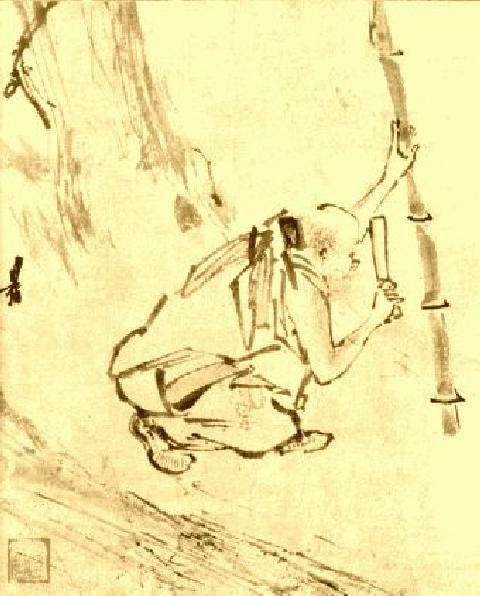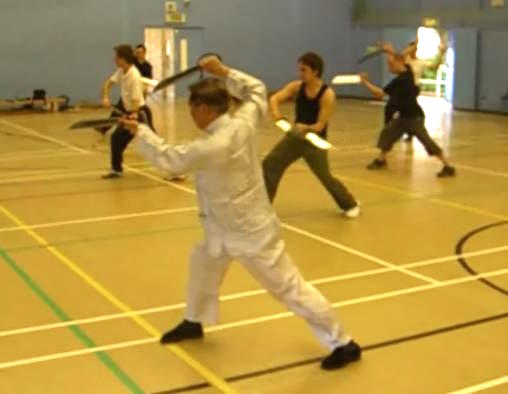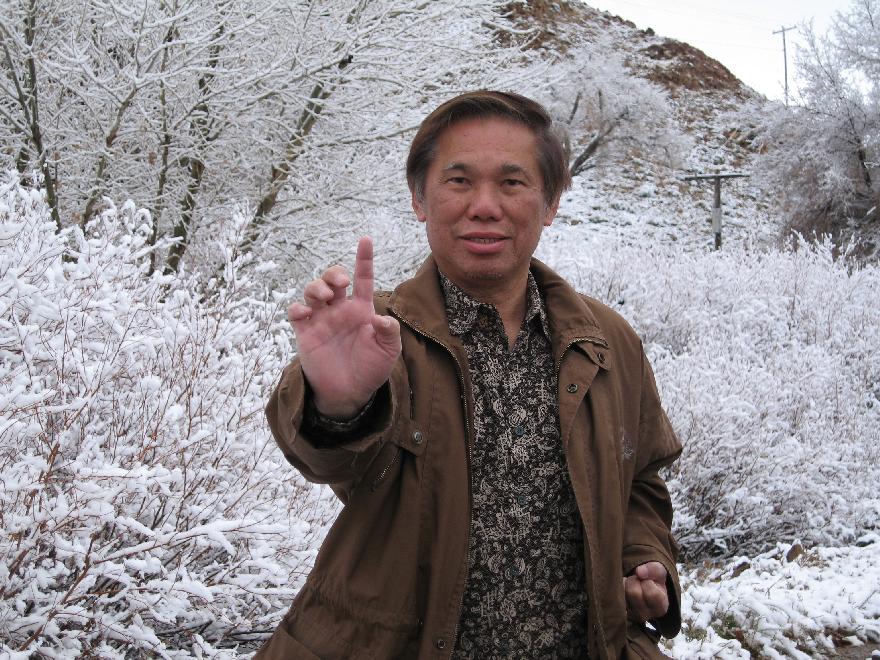September 2007 (Part 1)
SELECTION OF QUESTIONS AND ANSWERS

A famous painting by Liang Kai of the Six Patriarch Hui Neng cutting bamboo. This image is culled from http://oaks.nvg.org/hui-neng.html
Ten Years Old
Our Question-Answer Series is now 10 years old. We wish to thank all our readers for their continued support and encouragement. Our first issue can be accessed here and an Overview of all our issues can be found here.
Question 1
I wish to thank you for your wonderful teachings in the “Art of Shaolin Kungfu”. After nine years of study I realized that the purpose of purifying the mind is to attain Enlightenment. I now understand that the essence of mind or Suchness is the real Buddha. Thanks to Hui Neng the Chineese Buddha and Fifth Patriarch. Once Suchness is known, one is free from delusion and one's mind is in a state of Thusness. Thanks to the Diamond Sutra of the Fifth Patriarch.
— Martin, France
Answer
I am glad of your realization that the purpose of purifying the mind is to attain Enlightenment. This is the supreme attainment. But even far before this supreme attainment, we can have many benefits from purifying the mind, like having right understanding, having mental clarity and freshness, and being peaceful and happy.
The Venerable Hui Neng, whose teaching is distilled in the Platform Sutra, is the 6th Patriarch. The lineage of Zen transmission is as follows:
- Bodhidharma
- Hui Ke
- Seng Ca
- Dao Yin
- Hong Jen
- Hui Neng.
The first three patriarchs stayed at the Shaolin Temple in Henan Province. The 4th Patriarch, Dao Yin, moved south to the Dongshan Temple in Hubei Province. Hui Neng moved further south to Guangdong Province and taught in nemerous famous temples, but his main base was the Baolin Temple.
From Bodhidharma to Hui Neng, the master designated his successor. Hence, there were designated patriarchs. But Hui Neng did not designate a particular successor. He had thousands of students, 47 of whom were masters. Hui Neng asked them to spread Zen. Hence there were no designated patriarchs after him.
The first three Zen patriarchs used the Lankavatara Sutra as the main text in their teachings. But the 4th Patriarch used the Diamond Sutra because it was already popular in the district where he taught. Both the Lankavatara Sutra and the Diamond Sutra were the direct oral teaching of the Buddha, and later written down in words by great masters. The Platform Sutra was the direct oral teaching of Hui Neng, and writtern down in words by his disciples.
Question 2
I have a three year old spine/back injury. As a result my lower and mid spine are pulled off center, affecting my sciatic nerve and overtime became a problem for spine alignment. Is there a form of marital arts or qigong that can correct such a spine/back injury?
— Wu, USA
Answer
Yes, many of my students have overcome problems like yours. I shall describe just two case-histories, which were more serious than yours, one case many years ago when I first started teaching chi kung publicly, and the other more recently when I taught chi kung overseas.
Mr Chua from Malaysia, about 70 years old, had a spine injury that made him look pathetic. He was doubly bent. If you looked at him from one side, he was constantly bent forward at an angle of about 30 degrees at his upper back. He could never stand upright. If you look at him from the front, his body was constantly shifted to the right at the chest level.
At that time I taught chi kung in regular classes, i.e. once a week for a course of six months. My teaching then was vastly different from what and how I am teaching now. I taught many patterns, the Eighteen Lohan Hands, mainly at the physcial level, and students had to repeat each pattern many times. After repeating a few patterns many times for about four or five months, students were able to generate a chi flow.
To get the best benefit from my teaching, Mr Chua attended both my classes at Georgetown and Bukit Mertajam, though I taught the same material at these two towns. After completing one course, he would repeat the same course. He also practiced twice a day at home, as advised by me. His diligent practice paid off well. About a year later, his deformities disappeared. He became pain free and was able to happily stand upright.
This happened about 20 years ago, but I can remember his case very well. He is an inspiration. Not only he overcame his problems but he demonstrated great faith in the ability of chi kung to overcome what modern medicine considers an impossible task.
The second case was more recent, when my teaching methodology had improved tremendously. Over the years I improved from teaching 18 patterns in 6 months to teaching just 3 patterns in 8 hours, and students could generate a chi flow within the 8 hours instead of after 4 or 5 months as before! The speed-up was in the teaching. Students still needed to practice daily for a few months before their illness was overcome.
Many students overcame back and spine problems. One such student was Vincente from Servilla, Spain. His vertebrae were fused, and he could not turn nor bend his body. He moved like a robot.
Vintente attended my one-day chi kung course and went into vigorous chi flow movements that could have shocked his specialist doctor. While in chi flow he would bend forward and backward with sounds as if bones were crashing. Nevertheless he felt fine during the chi flows. After about 9 months his vertebra problem disappeared. He could move about like a normal person!
His doctor was surprised. She said that this could not happen, but it did, so she herself took a course from me to find out, and was much impressed. Needless to say, many of Vincente's friends who had similar problems took my courses too.
Question 3
In your Shaolin Kung Fu book when you explain the art of thirty punches, you mention it is important not to move your body, especially your shoulder. A bit earlier in the One Finger Shooting Zen section, you say it is important not to raise your shoulder.
So I suppose I'm just looking for some clarification. If I punch full force and try to keep all of the muscles relaxed that aren't necessary for the punching motion, I find that the momentum of my arm will carry my shoulder forward a bit. Also, I would push my shoulder forward a bit to try to extend the reach of the punch and perhaps add some power. Is this wrong?
— Julian, USA
Answer
It is not a matter of right or wrong here, but a matter of choosing the best method for the purpose. If you are practicing a physical exercise, the way you punch is not wrong. Indeed, many martial artists, especially those who practice external arts, favor to punch the way you described because it gives them more reach and body weight.
But for internal force training, the method you described is not suitable because it obstructs smooth energy flow. The method we use in Shaolin Wahnam is like what I described in my books on "Thrity Punches" and "One-Finger Shooting Zen" where we do not move our body and do not raise our shoulder. This method enables internal force to flow smoothly from our "dan tian" to our punch or finger where we wish to explode force.

Rotating the waist is very important in kungfu movements. Grandmaster Wong emphasizes the rotation of the waist when making a cutting strike with the Butterfly Knives at the Weapon Course during the UK Summer Camp of July 2007
Question 4
I find that not to let my shoulder move forward at all I have to lock my shoulder down and back by clenching my upper back muscles. Is this what I should be doing?
Answer
No, what you do here is not only incorrect but also harmful. Locking your shoulder and clenching your upper back muscles, or any muscles, cause energy blockage.
An internal force practitioner relaxes his muscles, yet he is very powerful. Indeed, the more relaxed he is, the more powerful he becomes. It is difficult for those not exposed to internal force training to appreciate this.
Internal force training needs to be learnt personally from a master, not from a book or video. Training internal force wrongly can bring a lot of harmful side-effects, and it is easy for you to train wrongly if you do not learn personally from a master.
Question 5
Is this just for the exercise or is this the way all punches should be performed in an actual combat situation?
Answer
We in Shaolin Wahnam perform in actual combat exactly the way we train. This is only logical.
It is ridiculous if you train in one way but use another way in combat. Yet a lot of kungfu practitioners, including some masters, are doing exactly this, i.e. they use kungfu techniques in training but use Kick-Boxing techniques in combat.
Question 6
I have been taught before that to attain maximum power you should rotate your entire upper body. Do you not train that rotation?
Answer
If you are referring to internal force, you have been taught wrongly. Indeed, many practitioners, including some masters, have this mis-conception. They probably misunderstood two important principles in internal froce training, namely rotating the waist and exploding energy from the "dan tian".
"Rotating the waist" means rotating the waist; it does not mean rotating the entire upper body. The waist rotation helps to explode internal force from the "dan tian". Later, when an internal martial art practitioner is skillful, he needs not rotate his waist to explode internal force.
As they did not learn the technique personally from a qualified teacher, some people attempt to rotate their waist by turning their shoulders. This adds mechanical strength to their punches but not internal force. But the power from mechanical strength is nothing close to the power from internal force.

One-Finger Shooting Zen is a treasure of Shaolin Wahnam. During his US tour in December 2006 at the scenic Arches National Park in Moab Utah, Grandmaster Wong was inspired by the beautiful scene to perform One-Finger Shoot Zen in the snow.
Question 7
In the case of One-Finger Shooting Zen, is it okay to let your shoulder slide forward as long as it does not raise upward?
Answer
For a practitioner who has internal force, it does not matter whether or not his shoulder slides forward or raises upward. In either case he still has internal force in his One-Finger Shooting Zen, although his result is better if his shoulder is still. Nevertheless, while he practiced One-Finger Shoot Zen to develop internal force, he had to keep his shoulder still, i.e. neither sliding forward nor raising upward.
For you, it also does not matter whether your shoulder slides forward or raises upward. In either case you still have no internal force in your One-Finger Shooting Zen. As a rough analogy, if you have money in your bank, it does not matter whether your shoulder slides forward or raises upward when you write a cheque. You will still get your money, although you will probably feel more comfortable when your shoulder is relaxed. But if you have no money in your bank, it also does not matter whether your shoulder slides forward or raises upward. In either case, you will not get any money from the bank.
I have clearly warned that internal force has to be learnt from a qualified teacher, and that practicing on your own without proper supervision is likely to bring harmful side-effects. Not only you do not heel my warning, you even change the training method I have mentioned in my books. You know that it is important not to move your body, yet you purposely move your shoulder forward. I would strongly advice you to stop training internal force on your own because the attitude you have is very likely to cause you a lot of trouble.
Question 8
As a general rule, how should you carry your shoulders?
I suppose this is a confusing question because the shoulders can refer to more than one thing. I was told that you should sort of cave in the chest, and bring the shoulders to the forward side of the body like you are pushing a heavy object, but it is still possible to lock the actual shoulder joint back and down to prevent movement.
Answer
Yours is not a confusing question. In fact, it is very clear that you are heading for a lot of trouble if you cave in your chest and carry your shoulders forward like pushing a heavy object.
LINKS
Selected Reading
- The Three Secrets
- Miraculous Experiences of Distant Chi Transmissions
- What would Yang Lu Chan do if a Muay Thai fighter throws continuous kicks at his ribs?
- Throwing an Opponent within Three Seconds
- Shaolin Traveling Dragon Sword with Poetic Names in Picture Series
